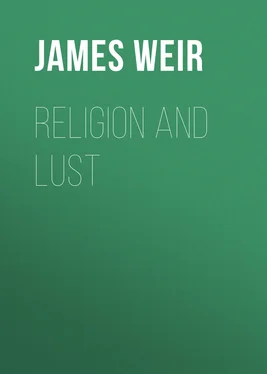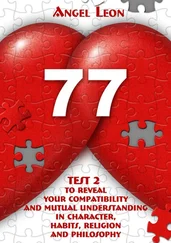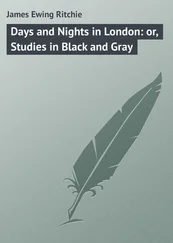James Weir - Religion and Lust
Здесь есть возможность читать онлайн «James Weir - Religion and Lust» — ознакомительный отрывок электронной книги совершенно бесплатно, а после прочтения отрывка купить полную версию. В некоторых случаях можно слушать аудио, скачать через торрент в формате fb2 и присутствует краткое содержание. Жанр: psy_sex_and_family, psy_sex_and_family, Эротика, Секс, Детская образовательная литература, Детская образовательная литература, на английском языке. Описание произведения, (предисловие) а так же отзывы посетителей доступны на портале библиотеки ЛибКат.
- Название:Religion and Lust
- Автор:
- Жанр:
- Год:неизвестен
- ISBN:нет данных
- Рейтинг книги:4 / 5. Голосов: 1
-
Избранное:Добавить в избранное
- Отзывы:
-
Ваша оценка:
- 80
- 1
- 2
- 3
- 4
- 5
Religion and Lust: краткое содержание, описание и аннотация
Предлагаем к чтению аннотацию, описание, краткое содержание или предисловие (зависит от того, что написал сам автор книги «Religion and Lust»). Если вы не нашли необходимую информацию о книге — напишите в комментариях, мы постараемся отыскать её.
Religion and Lust — читать онлайн ознакомительный отрывок
Ниже представлен текст книги, разбитый по страницам. Система сохранения места последней прочитанной страницы, позволяет с удобством читать онлайн бесплатно книгу «Religion and Lust», без необходимости каждый раз заново искать на чём Вы остановились. Поставьте закладку, и сможете в любой момент перейти на страницу, на которой закончили чтение.
Интервал:
Закладка:
Hundreds of pages have been written on snake-worship, in which a wonderful amount of metaphysical lore has been expended. Mr. Herbert Spencer devotes several pages to the snake, and the reason for its appearance in the religion of primitive peoples. He ascribes to savages a psychical acuteness that I am by no means willing to allow them, inasmuch as he makes them give a psychical causation for their adoption of the serpent as a deity, such as no ignorant and uncultivated savage could have possibly evolved. I am inclined to believe that, like all great students and thinkers, Mr. Spencer has a hobby, and that this hobby is animism or ancestor-worship. When he gives out, as a reason for the snake’s almost universal appearance in the religions of primitive peoples, that the latter consider it an animal which has assumed the returning ghost, double, or soul of an ancestor, 64 64 Spencer: Principles of Sociology , vol. i, p. 798.
I think that he is very much in error. There are very few primitive folk, comparatively speaking, who believe in metempsychosis. In all probability, when a race, like the ancient Egyptians, for instance, had reached a high degree of civilization, they idealized many of their religious beliefs and customs; hence, the serpent probably lost its initial and simple symbolical meaning, and stood for something higher and more ethical during the reign of the great Pharaohs, and the Golden Age of the Greeks and Latins. I am positive, however, that the snake’s original significance was wholly phallic in character, and that its adoption as a symbol was simple and material, as I explain elsewhere in this essay. 65 65 The appearance of the erect male organ of generation is quite sufficient to explain why the snake should be chosen as a symbol in phallic rites.
I am forced to this conclusion by its presence among phallic symbols in almost every race that practiced or practices a worship of the generative principles. The Pueblo Indians, whom I have mentioned elsewhere in this treatise, regard the snake symbol with reverence; the Moqui Indians have their sacred snake dance, in which they worship the reptiles, handling the most vicious and poisonous rattlesnakes with seeming impunity; the Apaches hold that every rattlesnake is an emissary of the devil; 66 66 Bancroft: Native Races, etc. , p. 135.
“the Piutes of Nevada have a demon deity in the form of a serpent still supposed to exist in the waters of Pyramid Lake;” 67 67 Ibid.
on the wall of an ancient Aztec ruin at Palenque there is a tablet, on which there is a cross standing on the head of a serpent, and surmounted by a bird. “The cross is the symbol of the four winds; the bird and serpent the rebus of the rain-god, their ruler.” 68 68 Bancroft (Brinton): Native Races, etc. , p. 135.
The Quiche god, Hurakan, was called the “Strong Serpent,” and the sign of Tlaloc, the Aztec rain-god, was a golden snake. 69 69 In the celebrated calendar stone of the Aztecs, there have been found certain hieroglyphics pointing to sun worship, coincidently, to phallicism.
All of these tribes are or were worshipers of the generative principles, though, in most of them, phallic worship has or had lost much of its original significance. 70 70 Ibid. , p. 134.
In Yucatan and elsewhere in South and Central America, notably among the ruins of Chichen Itza, the serpent symbol is frequently in evidence. 71 71 Stephens: Yucatan .
The Indians of the Tocantins in Brazil, as well as the Muras, Mundurucus and Cucamas, are mixed nature and devil worshipers; 72 72 Consult Frantz Keller: The Amazon and Madeira Rivers .
as a sequence, certain phallic rites are to be observed in their religious ceremonies.
Many of the native tribes of North America perform phallic rites at puberty. James Owen Dorsey, who has made a study of the Siouan cults, writes as follows:
“Every male Dakota sixteen years old and upward is a soldier, and is formally and mysteriously enlisted into the service of the war prophet. From him he receives the implements of war, carefully constructed after models furnished from the armory of the gods, painted after a divine prescription, and charged with a missive virtue—the tonwan—of the divinities. To obtain these necessary articles the proud applicant is required for a time to abuse himself and serve him, while he goes through a series of painful and exhausting performances, which are necessary on his part to enlist favorable notice of the gods. These performances consist chiefly of vapor baths, fastings, chants, prayers, and nightly vigils. The spear and the tomahawk being prepared and consecrated, the person who is to receive them approaches the wakan man (priest), and presents a pipe to him. He asks a favor, in substance as follows: ‘Pity thou me, poor and helpless, a woman , and confer on me the ability to perform manly deeds.’” 73 73 Dorsey: Siouan Cults, An. Rep. Bur. Eth. , 1889-90, p. 444.
According to Miss Fletcher, when an Oglala girl arrives at puberty, a great feast is prepared, and favored guests invited thereto. “A prominent feature in the feast is the feeding of these privileged persons and the girl in whose honor the feast is given, with choke cherries, as the choicest rarity to be had in the winter… In the ceremony, a few of the cherries are taken in a spoon and held over the sacred smoke and then fed to the girl.” 74 74 Fletcher: Peabody Museum Report , vol. iii, p. 260.
This is considered one of the most sacred of their feasts.
While discussing the phallic observances of the North American races, I will introduce the subject of tattooing, though it properly belongs elsewhere in this treatise.
At puberty, the Hudson Bay Eskimos invariably tattoo their boys and girls. Lucien M. Turner writing of the latter, says:
“When a girl arrives at puberty she is taken to a secluded locality by some old woman versed in the art of tattooing, and stripped of her clothing. A small quantity of half-charred lamp wick of moss is mixed with oil from the lamp. A needle is used to prick the skin, and the pasty substance is smeared over the wound. The blood mixes with it, and in a few days a dark-bluish spot is left. The operation continues four days. When the girl returns to the tent it is known that she has begun to menstruate.” 75 75 Turner: An. Rep. Bur. Eth. , 1889-90, p. 208.
Both Eastern and Western Inoits celebrate puberty with certain rites. It is rather difficult, however, to get them to say much about this matter, so I will not present the evidence, meager as it is, which has been gleaned from the works of various explorers. One can readily see that much of it is conjecture, therefore of little scientific value.
Not far from the Place of Gold, the magnificent temple in which the ancient Peruvians worshiped the Life Giver, was another great edifice, styled the “House of the Virgins of the Sun.” This was the domicile of the pallacides or hetaræ of the Chief Priest, the Inca. “No one but the Inca and the Coya, or queen, might enter the consecrated precincts… Woe to the unhappy maiden who was detected in an intrigue! By the stern laws of the Incas she was buried alive, her lover strangled, and the town or village to which he belonged was razed to the ground and sowed with stones as if to efface every memorial of his existence. One is astonished to find so close a resemblance between the institutions of the American Indian, the ancient Roman, and the modern Catholic. Chastity and purity of life are virtues in woman that would seem to be of equal estimation with the barbarian and with the civilized—yet the ultimate destination of the inmates of these religious houses (there were hundreds of them), was materially different… Though Virgins of the Sun, they were the brides of the Inca.” 76 76 Prescott: Conquest of Peru , vol. i, p. 110 et seq.
The monarch had thousands of these hetaræ in his various palaces. When he wished to lessen the number in his seraglios, he sent some of them to their own homes, where they lived ever after respected and revered as holy beings. 77 77 Ibid. , p. 112.
The religion of the Peruvians had reached a high degree of development, and many of the crudities of simple phallic worship had either been entirely abandoned or so idealized that they had been lost in the mists of ritual and ceremony. For “the ritual of the Incas involved a routine of observances as complex and elaborate as ever distinguished that of any nation, whether pagan or Christian.” 78 78 Ibid. , p. 103.
Интервал:
Закладка:
Похожие книги на «Religion and Lust»
Представляем Вашему вниманию похожие книги на «Religion and Lust» списком для выбора. Мы отобрали схожую по названию и смыслу литературу в надежде предоставить читателям больше вариантов отыскать новые, интересные, ещё непрочитанные произведения.
Обсуждение, отзывы о книге «Religion and Lust» и просто собственные мнения читателей. Оставьте ваши комментарии, напишите, что Вы думаете о произведении, его смысле или главных героях. Укажите что конкретно понравилось, а что нет, и почему Вы так считаете.












